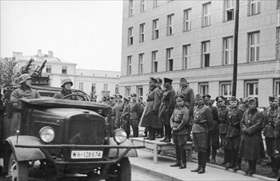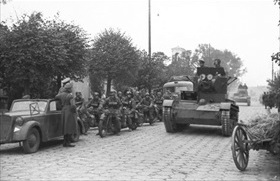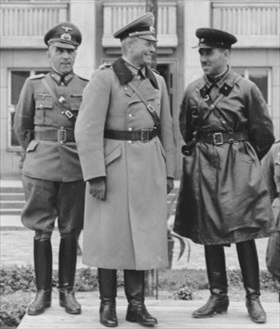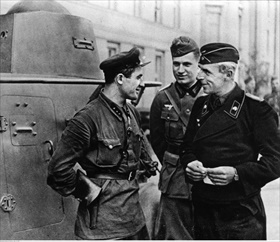NAZIS, SOVIETS DIVIDE POLISH SPOILS
Brest-Litovsk, Occupied Eastern Poland • September 19, 1939
Adolf Hitler’s armies stormed over Poland’s border on September 1, 1939, in what became known as the world’s first blitzkrieg—“lightning war.” Soviet dictator Joseph Stalin hastened to claim his share of the spoils under the terms of a secret protocol in the Molotov-Ribbentrop Nonaggression Treaty signed in Moscow less than a month before, sending two army groups totaling nearly 500,000 men into Eastern Poland, where on this date, September 19, 1939, they met the advancing Germans at Brest-Litovsk (Polish, Brześć), a rail and river hub on the right bank of the Bug River (effectively the demarcation between the 2 occupation armies). On September 22, as German troops withdrew westward out of the Soviet “zone of influence” in Poland, the 2 invaders celebrated a victory parade in Brest (in today’s Belarus). By the end of the month all Poland was under one tyranny or the other.
Despite their easy victory, the Germans lost 13,000 killed and over 27,000 wounded out of over 1 million men who took part in the Polish Campaign. The Soviets lost less than a thousand men because most combat was over by the time the Red Army surged over Poland’s border on September 17. (The Soviets timed their 1939 invasion to allow the Germans to destroy the bulk of Polish resistance they might encounter just as they did in 1944 outside Warsaw, Poland’s prewar capital. Indeed, the only enemy forces the Soviets faced were 12,000 men of the Border Protection Corps [KOP] and disorganized Polish troops fleeing north to the safety of Lithuania and south to Romania and Hungary.) Polish casualties were high: 70,000 killed and 133,000 wounded. Over 900,000 Poles became prisoners of war: nearly 700,000 in German hands and 217,000 in Soviet hands. Many who fell into the latter’s hands were packed into freight cars without food, water, or heat. Thousands died en route to labor camps, while many more were worked, starved, or frozen to death. The fate of at least 4,134 became known with the discovery of their buried bodies in the Katyn Forest in 1943. Each had been executed with a bullet in the back of the head.
After Hitler double-crossed his treaty partner by invading the Soviet Union in June 1941 (Operation Barbarossa), between 3.3 and 3.5 million Soviet POWs were targeted for forced labor and destruction by Nazi policies. Destruction took the form of neglect, abuse, malnutrition, deliberate starvation (with typical German thoroughness, the Nazis crafted a “Hungerplan” for its implementation), all the way down to murder, mostly by shooting and gassing. In the summer of 1944 the number of Soviet POWs used as forced laborers peaked at 631,000, many employed in coal mines in Germany’s Ruhr Valley or with firms like Krupp and Daimler-Benz. No fewer than 200,000 Soviet prisoners died as forced laborers.
By 1944 Poland was the site of 9 out of 40 Nazi death camps, whose inmates included Polish civilians, POWs, European Jews (overwhelmingly), Roma (Gypsies), and political prisoners. Not until the summer of 1944, when the advancing Red Army overran the abandoned camp at Majdanek on the outskirts of Lublin, Poland, where 79,000 people died (59,000 of them Polish Jews) did the true extent of the Nazis’ genocidal policies become clear. Six months later, on January 27, 1945, the Soviets liberated Auschwitz-Birkenau, the largest of the German labor and death camps where at least 1.3 million died—around 90 percent of them Jews but also 15,000 Soviet prisoners at Auschwitz and thousands more at Birkenau among the dead. (In 2005 the United National General Assembly designated January 27 as International Holocaust Remembrance Day.) Ovens, mounds of corpses, and emaciated survivors testified in words, photographs, and motion pictures the breadth and depth of Nazi depravity, which the Nazis inflicted on people they branded Untermenschen (subhumans).
German-Soviet Military Parade in Brest-Litovsk, Poland, on September 22, 1939, Marked the City’s Handover to the Red Army
 |  |
Left: German-Soviet military victory parade in Brest-Litovsk, Poland (today simply Brest in southwestern Belarus) on September 22, 1939, 4 days after the 2 armies made contact with each other. Both invaders, but particularly the Germans, saw the propaganda value in holding the parade, which was meant to showcase to the whole world the reality of the newly formed “Soviet-Nazi alliance” and attendant seismic shift in geopolitics. Onlookers were mostly from Brest’s non-Polish communities: Belorussians and Jews.
![]()
Right: Soviet T-26 tanks and German motorcyclists rolling over Brest’s cobblestone streets. The Soviet contribution to the joint victory parade was modest—a military band and a few battalions—because Red Army soldiers in their dirty boots, dusty greatcoats, and stubble beards were bone-tired after their protracted march to Brest.
 |  |
Left: Sharing the tiny, hastily constructed reviewing stand in Brest-Litovsk were (left to right) German General of the Infantry Mauritz von Wiktorin; Maj. Gen. Heinz Guderian, commander of German panzer (armored) forces in Poland; and Guderian’s Soviet counterpart Brig. Gen. Semyon Moiseevich Krivoshein, commander of the Soviet 29th Light Tank Brigade that took Brest-Litovsk. Guderian, resplendent in his red-lined greatcoat and black leather jackboots, and Krivoshein, belted leather coat and leather boots, conversed in French. Behind his smile on the reviewing stand, Guderian did his level best to hide his personal and professional disappointment: his men had fought 2 days to take Brest-Litovsk from the Poles only to learn that the secret Ribbentrop-Molotov Nonaggression protocol required the Germans to hand Brest-Litovsk over to the Soviets.
![]()
Right: German soldiers converse with a Soviet soldier in Brest-Litovsk. The city held historical significance for both Nazi Germany and the Soviet Union in that it was the site of a peace treaty signed by emissaries of Kaiser Wilhelm II’s government that extricated Bolshevik Russia from World War I. After the 1939 victory parade-cum-handover ceremony the Germans withdrew to the western bank of the River Bug, and the Soviets took control of Brest-Litovsk, which lay on the eastern bank, as well as the rest of Eastern Poland (now Western Belarus and Western Ukraine). The formal ratification of the German-Soviet Boundary and Friendship Treaty, which occurred on September 28, 1939, erased Poland from the European map for the next 5‑3/4 years. Germany added 77,600 sq. miles (200,983 sq. km) to its territorial holdings, the Soviet Union 72,780 sq. miles (188,292 sq. km).
German-Soviet Victory Parade, Brest-Litovsk, September 22, 1939 (No audio)
![]()

 History buffs, there is good news! The Daily Chronicles of World War II is now available as an ebook for $4.99 on Amazon.com. Containing a year’s worth of dated entries from this website, the ebook brings the story of this tumultuous era to life in a compelling, authoritative, and succinct manner. Featuring inventive navigation aids, the ebook enables readers to instantly move forward or backward by month and date to different dated entries. Simple and elegant! Click
History buffs, there is good news! The Daily Chronicles of World War II is now available as an ebook for $4.99 on Amazon.com. Containing a year’s worth of dated entries from this website, the ebook brings the story of this tumultuous era to life in a compelling, authoritative, and succinct manner. Featuring inventive navigation aids, the ebook enables readers to instantly move forward or backward by month and date to different dated entries. Simple and elegant! Click 











